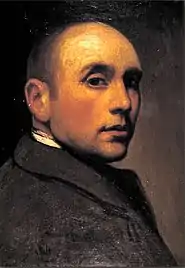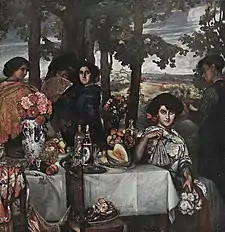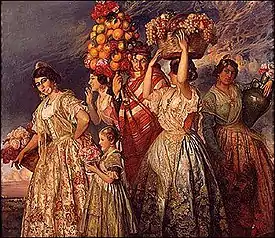José Pinazo Martínez
José Pinazo Martínez (10 July 1879, Rome - 2 December 1933, Madrid)[1] was a Spanish painter, primarily known for portraits and still-lifes.

Biography

He was born while his father, the painter Ignacio Pinazo Camarlench, was on a scholarship in Rome.[2] At the age of two, they returned to Spain and settled in Valencia where his brother, the sculptor, Ignacio Pinazo Martínez, was born in 1883.
As the son of an artist, he naturally became interested in painting at an early age and began studying with his father. Then he attended the Real Academia de Bellas Artes de San Carlos de Valencia. In 1895, when he was only sixteen, he entered his first work in the National Exhibition of Fine Arts and received honorable mention. He also won a silver medal at the Exposition Universelle (1900).[2] Later, he moved to Madrid to pursue his career. In 1906, he spent his time traveling between Paris, London and Rome. The following year, he married Magdalena Mitjans, from a old and once noble family. They would have two daughters.
In Madrid, he received appreciative notices from several prominent critics, including Manuel Abril and José Francés. The latter, under his pen name of "Silvio Lago", wrote an article for La Esfera, expressing his belief that Pinazo had reached his artistic maturity in 1910 with his painting "A Plena Vida" (A Full Life). In 1915, Pinazo was awarded a First Class prize at the National Exhibition for his large canvas "Floreal", for which Magdalena served as a model and helped select the costumes.
He participated in several international exhibitions; notably in Panama and St. Louis. In 1920, he visited the United States, but had little success until Magdalena was able to arrange a showing in New York at the Gimpel and Wildenstein gallery. The following year, he made an extended visit to Cuba, for a showing at the Salón de Bellas Artes de La Habana, after which he received several commissions.
In 1925, he made some significant changes in his style and held his last solo exhibition in Madrid, preferring to focus on foreign buyers; primarily in Buenos Aires. He received a major commission from Archer Milton Huntington, for the Hispanic Society of America, in 1929. Small showings followed at the Carnegie Institute (1930) and the Art Institute of Chicago (1931).

In the summer of 1933, while vacationing at El Escorial, he became ill with what was diagnosed as anthrax. As the weather grew colder, he developed septicemia, which proved fatal.
References
- Memorial @ Find-a-Grave
- Biography @ the Museo del Prado
Further reading
- Xesqui Castañer López, José Pinazo Martínez (1879-1933): Un pintor ecléctico entre la tradición y la modernidad, Punto Rojo, 2011 ISBN 978-84-15350-98-9 (Full text online)
- Silvio Lago, "Artistas contemporáneos: José Pinazo", from La Esfera, #128, 1916 (Online)
- Francisco Javier Péres Rojas, "El arte valenciano entre 1880 y 1920", from La ciudad de Valencia : historia, geografía y arte, University of Valencia, 2009 ISBN 978-84-370-7666-9 (Online)
External links
| Wikimedia Commons has media related to José Pinazo Martínez. |
- More works by Pinazo @ ArtNet